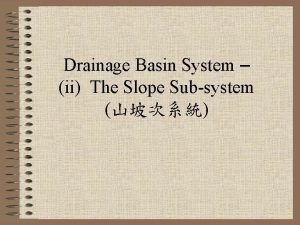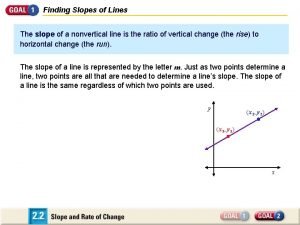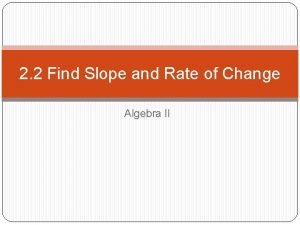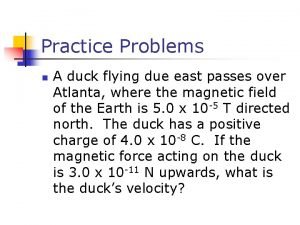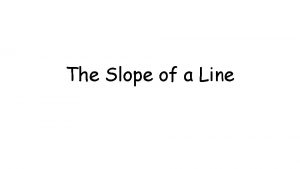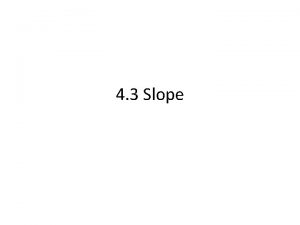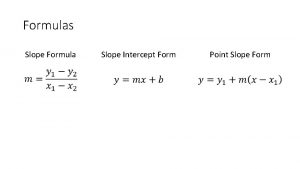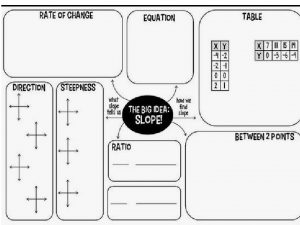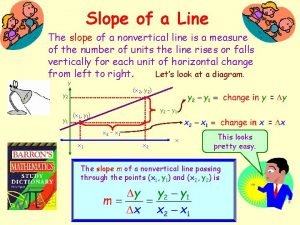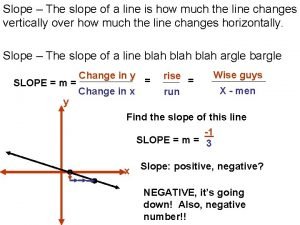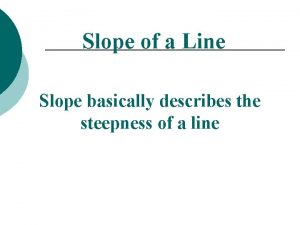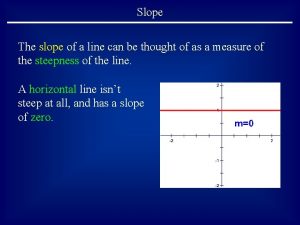Determine the slope of the line that passes



















- Slides: 19

Determine the slope of the line that passes through each pair of points: (3, 5) and (7, 12) (-2, 4) and (5, 4) (-3, 6) and (2, -6) (7, -2) and (7, 13) Determine the value of n so that the slope of the line through (n, 4) and (1, n) is .

Math 8 H 4 -2 Slope and Direct Variation Algebra 1 Glencoe Mc. Graw-Hill Jo. Ann Evans

A direct variation equation is a special type of linear equation. Every direct variation equation will graph as a line that passes through the origin. (0, 0) y x

When two quantities have a constant ratio, they are said to have a direct variation. The two quantities will be represented as y and x. Written in ratio form the ratio of y to x is . What ratio did we study in the previous lesson? SLOPE! In direct variation equations, the slope has a different name. It is known as the “constant of variation”.

Slope is the ratio of the change in y to the change in x. A direct variation equation is: In a direct variation equation k is called the constant of variation. On the graph of a direct variation equation k is the slope of the line.

Solve the direct variation equation for y. A direct variation equation represents a constant rate of change. “k” is the constant of variation

(1, 3) (0, 0) This is a graph of the direct variation equation y = 3 x. The constant of variation is 3. What is the slope of the line? The slope of the line is the same as the constant of variation.

This is a graph of the (4, 1) (0, 0) direct variation equation y= x. What is the constant of variation? What is the slope of the line? The slope of the line is the same as the constant of variation.

Remember: every direct variation equation will graph as a line that passes through the origin. y x

Graph y = 5 x y • • 1. Write the slope as a ratio. x 2. Plot a point at (0, 0). 3. Walk the slope. A slope of tells you to go UP 5, OVER 1. 4. Plot the point. Connect the two points with a line.

Graph y = x y • x • 1. The slope is already a ratio. Assign the negative to the numerator. 2. Plot a point at (0, 0). 3. Walk the slope. A slope of tells you to go DOWN 3, OVER 4. 4. Plot the point. Connect the two points with a line.

Graph y = x Graph y = -x y • x • • x What is the slope? It’s -1. Written as a ratio, that’s .

Y varies directly as x. Write a direct variation equation that relates x and y. If y = -27 when x = -3, find x when y = 108. Use this information to write the direct variation equation. Using the equation, answer the question. x equals 12 when y = 108.

Y varies directly as x. Write a direct variation equation that relates x and y. If y = -15 when x = 5, find x when y = -87. Use this information to write the direct variation equation. Using the equation, answer the question. x equals 29 when y = -87.

Y varies directly as x. Write a direct variation equation that relates x and y. If y = 7. 5 when x = 0. 5, find y when x = -0. 3. Use this information to write the direct variation equation. Using the equation, answer the question. y equals -4. 5 when x = -. 3.

Y varies directly as x. Write a direct variation equation that relates x and y. If y = 12 when x = 18, find x when y = -16. Use this information to write the direct variation equation. Using the equation, answer the question. x equals 24 when y = -16.

The cost of bananas varies directly with their weight. If 3 pounds of bananas cost $2. 04, find the cost of 4 pounds. Write a direct variation equation that relates the cost, c, to the weight, w. Use the equation to answer the question. If c = $2. 04 when w = 3, find c when w = 4. The cost is $2. 72 for 4 lb. of bananas.

d = rt is a direct variation equation! Distance (d) varies directly as time (t). The rate (r) is the constant of variation. A hot air balloon’s distance of ascent varies directly as the time. The balloon ascended 372 feet in six minutes. Write a direct variation equation that relates the distance, d, to the time, t. d = rt (372) = r(6) 62 = r The balloon’s ascent rate is 62 feet per minute. d = 62 t is the direct variation equation.

Use the direct variation equation to find how long will it take for the balloon to rise 1209 feet. d = 62 t (1209) = 62 t 19. 5 = t The balloon should ascend 1209 feet in 19. 5 minutes.
 International date line passes through
International date line passes through Slope of budget line or price line is
Slope of budget line or price line is Phân độ lown
Phân độ lown Block nhĩ thất độ 2 mobitz 1
Block nhĩ thất độ 2 mobitz 1 Thơ thất ngôn tứ tuyệt đường luật
Thơ thất ngôn tứ tuyệt đường luật Thơ thất ngôn tứ tuyệt đường luật
Thơ thất ngôn tứ tuyệt đường luật Chiến lược kinh doanh quốc tế của walmart
Chiến lược kinh doanh quốc tế của walmart Tìm độ lớn thật của tam giác abc
Tìm độ lớn thật của tam giác abc Hãy nói thật ít để làm được nhiều
Hãy nói thật ít để làm được nhiều Tôn thất thuyết là ai
Tôn thất thuyết là ai Gây tê cơ vuông thắt lưng
Gây tê cơ vuông thắt lưng Sau thất bại ở hồ điển triệt
Sau thất bại ở hồ điển triệt Slope decline theory
Slope decline theory Converting point slope to slope intercept
Converting point slope to slope intercept Slope review classifying slope
Slope review classifying slope Slope review classifying slope
Slope review classifying slope Eg subject code
Eg subject code Does the moon rotate
Does the moon rotate As nutritional energy passes through the food chain, energy
As nutritional energy passes through the food chain, energy A duck flying due east passes over atlanta
A duck flying due east passes over atlanta












